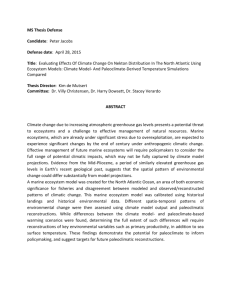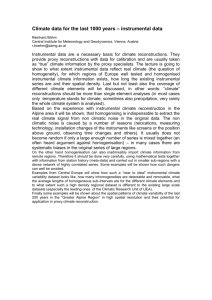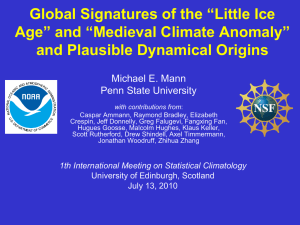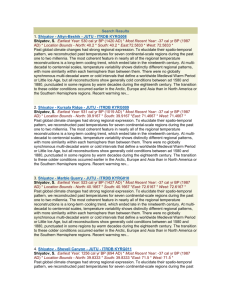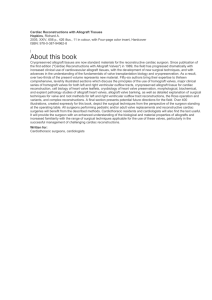B Surface Temperature Reconstructions for the Last 2,000 Years
advertisement
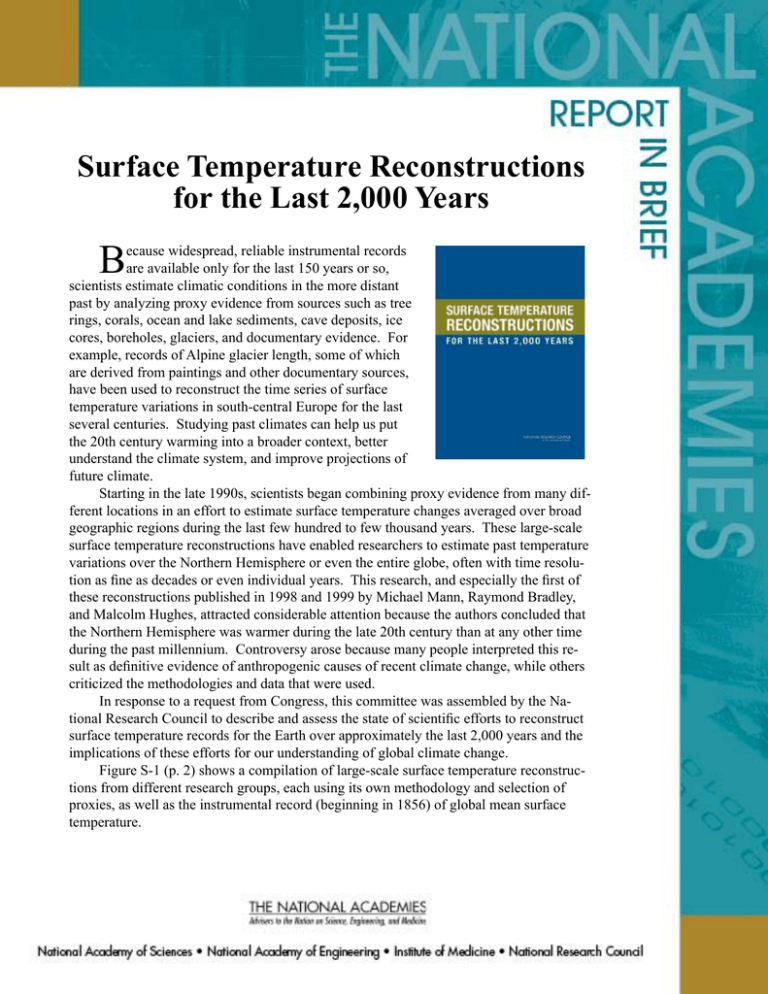
Surface Temperature Reconstructions for the Last 2,000 Years B ecause widespread, reliable instrumental records are available only for the last 150 years or so, scientists estimate climatic conditions in the more distant past by analyzing proxy evidence from sources such as tree rings, corals, ocean and lake sediments, cave deposits, ice cores, boreholes, glaciers, and documentary evidence. For example, records of Alpine glacier length, some of which are derived from paintings and other documentary sources, have been used to reconstruct the time series of surface temperature variations in south-central Europe for the last several centuries. Studying past climates can help us put the 20th century warming into a broader context, better understand the climate system, and improve projections of future climate. Starting in the late 1990s, scientists began combining proxy evidence from many different locations in an effort to estimate surface temperature changes averaged over broad geographic regions during the last few hundred to few thousand years. These large-scale surface temperature reconstructions have enabled researchers to estimate past temperature variations over the Northern Hemisphere or even the entire globe, often with time resolution as fine as decades or even individual years. This research, and especially the first of these reconstructions published in 1998 and 1999 by Michael Mann, Raymond Bradley, and Malcolm Hughes, attracted considerable attention because the authors concluded that the Northern Hemisphere was warmer during the late 20th century than at any other time during the past millennium. Controversy arose because many people interpreted this result as definitive evidence of anthropogenic causes of recent climate change, while others criticized the methodologies and data that were used. In response to a request from Congress, this committee was assembled by the National Research Council to describe and assess the state of scientific efforts to reconstruct surface temperature records for the Earth over approximately the last 2,000 years and the implications of these efforts for our understanding of global climate change. Figure S-1 (p. 2) shows a compilation of large-scale surface temperature reconstructions from different research groups, each using its own methodology and selection of proxies, as well as the instrumental record (beginning in 1856) of global mean surface temperature. After considering all of the available evidence, including the curves shown in Figure S-1, the committee has reached the following conclusions: • The instrumentally measured warming of about 0.6°C during the 20th century is also reflected in borehole temperature measurements, the retreat of glaciers, and other observational evidence, and can be simulated with climate models. • Large-scale surface temperature reconstructions yield a generally consistent picture of temperature trends during the preceding millennium, including relatively warm conditions centered around A.D. 1000 (identified by some as the “Medieval Warm Period”) and a relatively cold period (or “Little Ice Age”) centered around 1700. The existence and extent of a Little Ice Age from roughly 1500 to 1850 is supported by a wide variety of evidence including ice cores, tree rings, borehole temperatures, glacier length records, and historical documents. Evidence for regional warmth during medieval times can be found in a diverse but more limited set of records including ice cores, tree rings, marine sediments, and historical sources from Europe and Asia, but the exact timing and duration of warm periods may have varied from region to region, and the magnitude and geographic extent of the warmth are uncertain. • It can be said with a high level of confidence that global mean surface temperature was higher during the last few decades of the 20th century than during any comparable period during the preceding four centuries. This statement is justified by the consistency of the evidence from a wide variety of geographically diverse proxies. • Less confidence can be placed in large-scale surface temperature reconstructions for the period from A.D. 900 to 1600. Presently available Figure S-1. Smoothed reconstructions of large-scale (Northern Hemisphere mean or global mean) surface temperature variations from six different research teams are shown along with the instrumental record of global mean surface temperature. Each curve portrays a somewhat different history of temperature variations, and is subject to a somewhat different set of uncertainties that generally increase going backward in time (as indicated by the gray shading). This set of reconstructions conveys a qualitatively consistent picture of temperature changes over the last 1,100 years, and especially the last 400. proxy evidence indicates that temperatures at many, but not all, individual locations were higher during the past 25 years than during any period of comparable length since A.D. 900. The uncertainties associated with reconstructing hemispheric mean or global mean temperatures from these data increase substantially backward in time through this period and are not yet fully quantified. • Very little confidence can be assigned to statements concerning the hemispheric mean or global mean surface temperature prior to about A.D. 900 because of sparse data coverage and because the uncertainties associated with proxy data and the methods used to analyze and combine them are larger than during more recent time periods. The main reason that our confidence in large-scale surface temperature reconstructions is lower before A.D. 1600 and especially before A.D. 900 is the relative scarcity of precisely dated proxy evidence. Other factors limiting our confidence in surface temperature reconstructions include the relatively short length of the instrumental record (which is used to calibrate and validate the reconstructions); the fact that all proxies are influenced by a variety of climate variables; the possibility that the relationship between proxy data and local surface temperatures may have varied over time; the lack of agreement as to which methods are most appropriate for calibrating and validating large-scale reconstructions and for selecting the proxy data to include; and the difficulties associated with constructing a global or hemispheric mean temperature estimate using data from a limited number of sites and with varying chronological precision. All of these considerations introduce uncertainties that are difficult to quantify. Despite these limitations, the committee finds that efforts to reconstruct temperature histories for broad geographic regions using multiproxy methods are an important contribution to climate research and that these large-scale surface temperature reconstructions contain meaningful climatic signals. The individual proxy series used to create these reconstructions generally exhibit strong correlations with local environmental conditions, and in most cases there is a physical, chemical, or physiological reason why the proxy reflects local temperature variations. Our confidence in the results of these reconstructions becomes stronger when multiple independent lines of evidence point to the same general result, as in the case of the Little Ice Age cooling and the 20th century warming. The basic conclusion of Mann et al. (1998, 1999) was that the late 20th century warmth in the Northern Hemisphere was unprecedented during at least the last 1,000 years. This conclusion has subsequently been supported by an array of evidence that includes both additional large-scale surface temperature reconstructions and pronounced changes in a variety of local proxy indicators, such as melting on icecaps and the retreat of glaciers around the world, which in many cases appear to be unprecedented during at least the last 2,000 years. Not all individual proxy records indicate that the recent warmth is unprecedented, although a larger fraction of geographically diverse sites experienced exceptional warmth during the late 20th century than during any other extended period from A.D. 900 onward. Based on the analyses presented in the original papers by Mann et al. and this newer supporting evidence, the committee finds it plausible that the Northern Hemisphere was warmer during the last few decades of the 20th century than during any comparable period over the preceding millennium. The substantial uncertainties currently present in the quantitative assessment of largescale surface temperature changes prior to about A.D. 1600 lower our confidence in this conclusion compared to the high level of confidence we place in the Little Ice Age cooling and 20th century warming. Even less confidence can be placed in the original conclusions by Mann et al. (1999) that “the 1990s are likely the warmest decade, and 1998 the warmest year, in at least a millennium” because the uncertainties inherent in temperature reconstructions for individual years and decades are larger than those for longer time periods, and because not all of the available proxies record temperature information on such short timescales. Surface temperature reconstructions for periods prior to the industrial era are only one of multiple lines of evidence supporting the conclusion that climatic warming is occurring in response to human activities, and they are not the primary evidence. Surface temperature reconstructions also provide a useful source of information about the variability and sensitivity of the climate system. To within existing uncertainties, climate model simulations show that the estimated temperature variations during the two millennia prior to the Industrial Revolution can be explained plausibly by estimated variations in solar radiation and volcanic activity during the same period. Large-scale surface temperature reconstructions have the potential to further improve our knowledge of temperature variations over the last 2,000 years, particularly if additional proxy evidence can be identified and obtained from areas where the coverage is relatively sparse and for time periods before A.D. 1600 and especially before A.D. 900. Furthermore, it would be helpful to update proxy records that were collected decades ago, in order to develop more reliable calibrations with the instrumental record. Improving access to data used in publications would also increase confidence in the results of large-scale surface temperature reconstructions both inside and outside the scientific community. New analytical methods, or more careful use of existing ones, may also help circumvent some of the existing limitations associated with surface temperature reconstructions based on multiple proxies. Finally, because some of the most important potential consequences of climate change are linked to changes in regional circulation patterns, hurricane activity, and the frequency and intensity of droughts and floods, regional and large-scale reconstructions of changes in other climatic variables, such as precipitation, over the last 2,000 years would provide a valuable complement to those made for temperature. In summary, large-scale surface temperature reconstructions are proving to be important tools in our understanding of global climate change. They contribute evidence that allows us to say, with a high level of confidence, that global mean surface temperature was higher during the last few decades of the 20th century than during any comparable period during the preceding four centuries. Committee on Surface Temperature Reconstructions for the Last 2,000 Years: Gerald R. North (Chair), Texas A&M University, College Station; Franco Biondi, University of Nevada, Reno; Peter Bloomfield, North Carolina State University, Raleigh; John R. Christy, University of Alabama, Huntsville; Kurt M. Cuffey, University of California, Berkeley; Robert E. Dickinson, Georgia Institute of Technology, Atlanta; Ellen R.M. Druffel, University of California, Irvine; Douglas Nychka, National Center for Atmospheric Research, Boulder, Colorado; Bette Otto-Bliesner, National Center for Atmospheric Research, Boulder, Colorado; Neil Roberts, University of Plymouth, United Kingdom; Karl K. Turekian, Yale University, New Haven, Connecticut; John M. Wallace, University of Washington, Seattle; Ian Kraucunas (Study Director), National Research Council’s Board on Atmospheric Sciences and Climate. For more information, contact the Board on Atmospheric Sciences and Climate at (202) 334-2546 or visit http://dels.nas.edu/basc. Copies of Surface Temperature Reconstructions for the Last 2,000 Years are available from the National Academies Press, 500 Fifth Street, NW, Washington, D.C. 20001; (800) 624-6242; www.nap.edu. Related titles from the National Academies Understanding and Responding to Climate Change (March 2006) Radiative Forcing of Climate Change (2005) Understanding Climate Change Feedbacks (2003) Climate Change Science: An Analysis of Some Key Questions (2001) © 2006 The National Academy of Sciences
